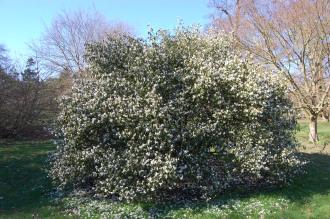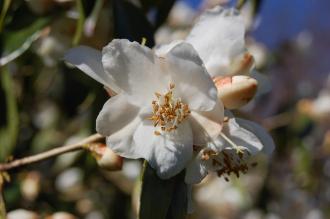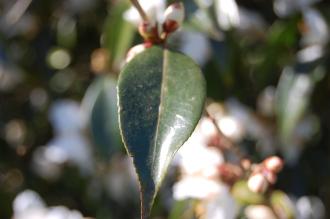
Camellia cuspidata (16/03/2014, Kew Gardens, London)
Position: Dappled to full shade
Flowering: Spring
Soil: Moist, well-drained, acidic
Eventual Height: 3m
Eventual Spread: 3m
Hardiness: 7a, 7b, 8a, 8b, 9a, 9b, 10a
Family: Theaceae
Camellia cuspidata is an evergreen flowering shrub with a bushy habit. Its dark green leathery leaves are elliptic with serrulate margins and a cuneate tip, paler on the underside, up to 7cm long and 3cm broad. Its new leaves appear reddish in color. Its single white flowers have protruding yellow stamen are up to 3cm across and appear along the branches, particularly at the ends.

Camellia cuspidata Flower (16/03/2014, Kew Gardens, London)
Camellia cuspidata, commonly know as Camellia,is native to south China. In it native habitat it grows as an understory plant in forests. This plant should be positioned in a site sheltered from cold, dry winds and early morning sun as buds and flowers may be damaged by cold winds and late frosts.
The etymological root of the binomial name Camellia is derived from and named after the botanist George Kamel. Cuspidata is derived from the Latin cuspidatim meaning ‘with a point’, in reference to its leaves.
The landscape architect may find Camellia cuspidata useful an evergreen, spring flowering shrub which will tolerate shaded conditions and acidic soils.

Camellia cuspidata Leaf (16/03/2014, Kew Gardens, London)
Ecologically, Camellia cuspidata is of little wildlife value in the UK.
Camellia cuspidata prefers moist, humus rich, fertile, well-drained soils. It prefers neutral to acidic soils.
Camellia cuspidata requires little maintenance. If necessary, pruning should be carried out after flowering.

